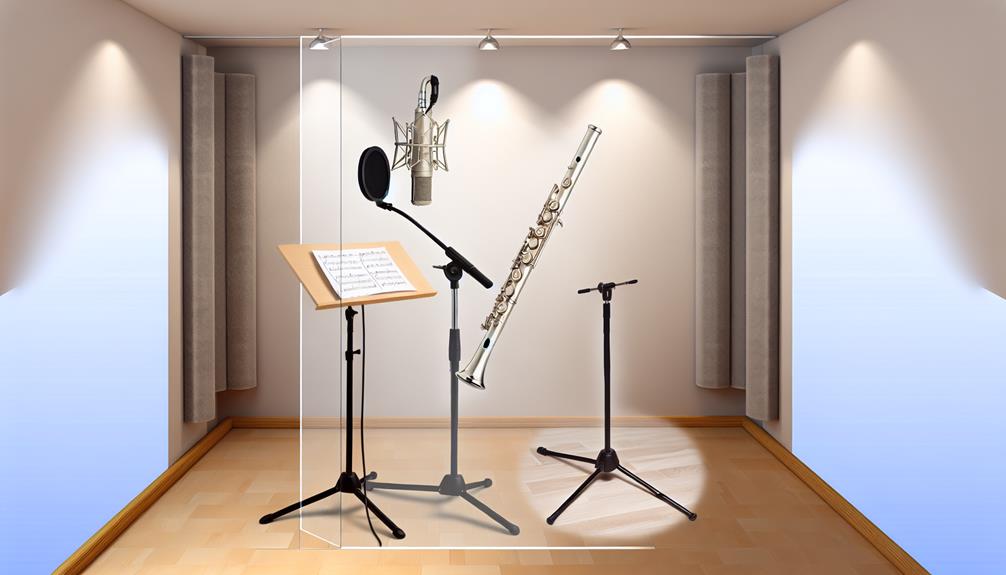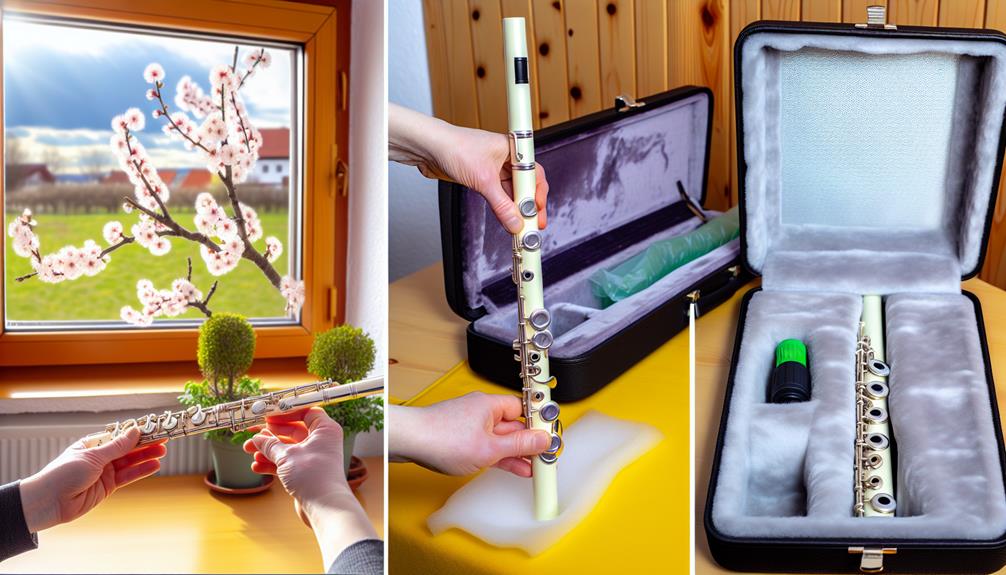Mastering flute scales is a fundamental step in a beginner flutist's musical journey. Understanding the intricacies of scales not only enhances technical skills but also lays a solid foundation for musical interpretation. From the fluidity of chromatic scales to the soulful tones of blues scales, each variation offers a unique challenge and opportunity for growth. By delving into the world of scales, beginners can unlock a treasure trove of musical possibilities and pave the way for a fulfilling flute-playing experience.
Key Takeaways
- Flute scales build music foundation, improve technique, and enhance agility.
- Memorize fingerings for smooth transitions and clear notes.
- Practice varied scales, use a metronome, and focus on dynamics.
- Major scales aid in understanding harmony and theory, use circle of fifths.
- Minor scales add emotional depth, practice for fluency and melodic variations.
Benefits of Learning Flute Scales
Understanding the benefits of incorporating flute scales into your practice routine can significantly enhance your overall musical proficiency and performance skills. Flute scales serve as the building blocks of music, aiding in improving technique and building dexterity. By practicing scales regularly, you are not just going through the motions but actively training your fingers to move swiftly and accurately across the keys. This deliberate practice refines muscle memory, leading to smoother transitions between notes and increased agility in playing complex pieces.
Moreover, mastering flute scales can have a profound impact on your overall musicality. As you become more comfortable with scales, you will notice a marked improvement in your tone production, intonation, and phrasing. These foundational skills are essential for any musician looking to elevate their playing to the next level. Additionally, fluency in scales allows for greater freedom of expression during performances, enabling you to convey emotions and nuances more effectively through your music.
In essence, learning and practicing flute scales is not just about technical proficiency; it is about developing a deeper connection with your instrument and honing your craft. Embrace the process, stay committed to regular practice, and witness how incorporating scales into your routine can transform your playing in ways you never thought possible.
Types of Flute Scales
Exploring the various types of flute scales can provide valuable insights into the diverse range of musical patterns and structures available for aspiring flutists. Understanding these different scales opens up a world of musical possibilities and can enhance your playing in various genres. Here are some key types of flute scales to familiarize yourself with:
| Scale Type | Description |
|---|---|
| Chromatic scales | Consist of all 12 pitches in an octave, moving in half steps. They are great for practicing intonation and developing finger dexterity. |
| Pentatonic scales | Comprised of five notes per octave, these scales are commonly used in folk and traditional music. They provide a simple yet melodious sound that can be quite expressive. |
| Blues scales | Often used in jazz and blues music, these scales incorporate blue notes for a unique and soulful sound. They are great for improvisation and adding emotion to your playing. |
| Whole tone scales | Made up entirely of whole steps, these scales have an ethereal and dreamy quality. They are perfect for creating a sense of ambiguity and tension in your music. |
Each of these scales offers a distinct flavor and can add depth to your musical repertoire. Experiment with different scales to expand your musical horizons and find your unique voice on the flute.
Essential Fingerings for Scales
Mastering the essential fingerings for scales is fundamental for developing fluency and agility in your flute playing technique. Finger placement on the keys of the flute is crucial for producing accurate and clear notes. Each scale has a specific set of fingerings that must be memorized and executed with precision to ensure smooth transitions between notes. As you practice scales, pay close attention to your finger placement and make adjustments as needed to improve the clarity and quality of your sound.
In addition to finger placement, breath control plays a significant role in mastering flute scales. Proper breath control allows you to sustain notes for the required duration and achieve a consistent tone throughout the scale. Focus on maintaining steady airflow while playing scales, using your diaphragm to support each note and avoid running out of breath prematurely. Practice breathing exercises to strengthen your respiratory muscles and improve your overall breath control when playing scales.
Tips for Practicing Scales
To enhance your proficiency in playing flute scales, incorporating focused practice routines can significantly elevate your skill level and musical expression. When practicing scales, consider exploring scale variations to add depth to your playing. Experiment with different articulations, dynamics, and rhythms within the scales to develop a versatile and expressive style. Additionally, integrating various practice techniques such as playing scales in thirds, fourths, or in contrary motion can enhance your technical abilities and ear training.
Utilizing a metronome during scale practice is crucial for developing a steady tempo, improving rhythm, and honing precision. Start at a comfortable tempo and gradually increase the speed as you become more comfortable with the scales. The metronome will help you maintain consistency and accuracy in your playing.
Scale memorization is another key aspect of effective practice. Aim to memorize the fingerings, note names, and intervals of each scale to build a strong foundation for your flute playing. Once you have internalized the scales, you can focus on musical interpretation and phrasing without being restricted by sheet music.
Incorporating these tips into your practice routine will not only enhance your technical skills but also deepen your musicality and expression when playing flute scales. Stay dedicated to your practice, be patient with yourself, and enjoy the journey of mastering this essential aspect of flute playing.
Understanding Major Scales
Understanding the concept of major scales is fundamental for every aspiring flutist aiming to broaden their musical knowledge and technical proficiency. Major scales are built on a specific pattern of intervals, which gives them their characteristic sound. These scales are essential as they form the foundation for understanding harmony, melody, and music theory in general.
One crucial aspect of major scales is the relationship between notes, which can be better understood through the circle of fifths. The circle of fifths visually represents the relationship between different keys and helps musicians understand the number of sharps or flats in each key signature. Key signatures are vital in indicating which notes are to be played sharp or flat throughout a piece of music in a particular key. Additionally, it is important to grasp the concept of enharmonic equivalents, where the same pitch can be notated in different ways, such as C# and Db.
As you delve into major scales, pay close attention to the intervals between notes. These intervals determine the unique sound and character of each scale. Practice playing major scales in different keys to familiarize yourself with their distinct patterns and fingering techniques. By mastering major scales, you will not only enhance your technical skills but also develop a deeper understanding of music theory, providing a solid foundation for your musical journey.
Exploring Minor Scales
Now, let's embark on an exploration of the captivating realm of minor scales, unveiling a new dimension of musical depth and expression for aspiring flutists. Minor scales possess a unique emotional quality that differs from the brightness of major scales. They add richness and complexity to your musical repertoire, offering a wide range of melodic variations that can evoke feelings of melancholy, mystery, or introspection.
To fully grasp the essence of minor scales, it is essential to practice technical exercises that enhance your fluency and agility on the flute. Begin by familiarizing yourself with the natural minor scale, which follows a pattern of whole and half steps that create its distinctive sound. Once you feel comfortable with the natural minor scale, you can explore harmonic and melodic minor scales, each with their own unique characteristics and melodic variations.
Technical exercises such as scale runs, arpeggios, and interval jumps will help you master the minor scales and build the dexterity needed to navigate through their intricate patterns. Remember to practice with a focus on tone quality, intonation, and phrasing to truly capture the expressive potential of minor scales.
Incorporating minor scales into your practice routine will not only broaden your musical horizons but also deepen your understanding of music theory and composition. Embrace the challenge, experiment with different interpretations, and let the evocative nature of minor scales inspire your musical journey.
Advantages of Scale Exercises
Scale exercises serve as a foundational pillar in the development of a flutist's technical proficiency and musical expression. By regularly practicing scales, a flutist can experience a myriad of advantages that contribute to their growth and mastery of the instrument. One key benefit is the improvement in technique and the development of muscle memory. Repetition of scale exercises helps in strengthening the fingers, enhancing agility, and improving overall dexterity, which are essential elements for playing the flute with ease and precision.
Additionally, scale exercises play a crucial role in enhancing intonation and ear training. As flutists navigate through different scales, they learn to recognize intervals, pitch relationships, and tonal colors. This heightened sense of pitch awareness not only improves intonation while playing scales but also carries over to playing melodies and pieces accurately. Ear training is essential for musicians to develop a keen sense of listening, enabling them to play in tune with other musicians in ensembles or orchestras.
Common Mistakes to Avoid
As flutists strive to harness the benefits of scale exercises for technical proficiency and musical expression, it is imperative to be mindful of common mistakes that can hinder progress and growth in playing the flute.
Improper technique is a significant pitfall that many beginners fall into. It is crucial to pay attention to fundamentals such as hand position, embouchure, and posture. Without proper technique, flutists may struggle to produce clear and consistent tones, affecting their overall sound quality and musicality.
Consistency is another key aspect that aspiring flutists must prioritize. Practicing scales sporadically or only when convenient can impede progress. To see improvement, regular and focused practice is essential.
Lack of consistency can lead to stagnation in skill development and hinder the ability to tackle more challenging pieces effectively. Furthermore, flutists should be wary of rushing through scale exercises. While it may be tempting to play scales quickly to get through practice sessions faster, this approach can result in sloppy technique and missed opportunities for improvement.
Patience and attention to detail are crucial when practicing scales to ensure that each note is played accurately and with the right tone. By avoiding these common mistakes and approaching scale exercises with diligence and focus, flutists can make significant strides in their musical journey towards mastering the flute.
Incorporating Scales in Repertoire
To enhance their musical performances and technical skills, flutists can elevate their repertoire by skillfully integrating scales into their pieces. By incorporating scales into their repertoire, flutists can not only improve their performance techniques but also enhance the musicality of their playing. Scale embellishments can add depth and complexity to a piece, showcasing the flutist's skill and artistry.
Here is a table highlighting the benefits of incorporating scales into repertoire:
| Benefits | Description |
|---|---|
| Performance Techniques | Incorporating scales helps in mastering fingerings, articulations, and dynamics. |
| Repertoire Selection | Scales can be used to choose pieces that complement a flutist's technical abilities. |
| Scale Embellishments | Adding scale runs or arpeggios can enhance the beauty and complexity of a piece. |
| Musicality | Scales aid in developing a strong sense of pitch, tone quality, and phrasing. |
Frequently Asked Questions
Can Playing Flute Scales Help Improve My Overall Musicality?
Playing flute scales can significantly enhance your musicality by improving your understanding of musical expression and refining articulation techniques.
Scales provide a foundation for developing a deeper connection with your instrument and honing your ability to convey emotions through music.
Mastering scales equips you with the skills needed to express yourself more effectively, adding depth and nuance to your performances.
Embrace the journey of scale practice as a vital step towards musical growth and expression.
How Can I Prevent My Fingers From Getting Fatigued While Practicing Scales?
To prevent finger fatigue while practicing scales, focus on incorporating finger exercises that improve strength and dexterity.
Prioritize relaxation techniques to reduce tension and strain.
Pay attention to your technique and posture, ensuring that your fingers are moving efficiently and without unnecessary tension.
Are There Specific Scales That Are More Beneficial for Beginners to Start With?
When starting out on the flute, beginners often benefit from mastering simple scale progressions, such as the C major scale, before moving on to more complex variations.
These foundational scales not only help in developing finger dexterity through basic finger exercises but also provide a solid base for understanding scale variations and honing breathing techniques.
What Are Some Creative Ways to Incorporate Scales Into My Daily Practice Routine?
Incorporating scales into your daily practice routine can be an engaging process. Scale duets can add a fun and interactive element, allowing you to play alongside a partner to improve your timing and intonation.
Experimenting with scale variations such as playing them in different rhythms or articulations can also keep your practice sessions fresh and challenging.
Is It Normal to Experience Frustration or Boredom While Practicing Scales?
It is common for musicians to experience frustration or boredom when practicing scales, as repetition can sometimes feel tedious. To manage frustration, setting small achievable goals, varying practice routines, and seeking inspiration from diverse musical sources can be effective.
Overcoming boredom can be achieved by incorporating creative practice techniques, such as playing scales in different rhythms or styles. Remember, staying motivated is essential, and finding joy in the process can make scale practice more enjoyable.
Conclusion
In conclusion, mastering flute scales is crucial for beginner flutists to improve their technical skills and musical understanding.
Did you know that practicing scales can increase finger coordination by up to 30% in just a few weeks?
By dedicating time to learning and practicing scales, beginners can enhance their playing abilities and progress towards more advanced musical pieces.
Keep practicing, stay disciplined, and watch your skills soar to new heights.






